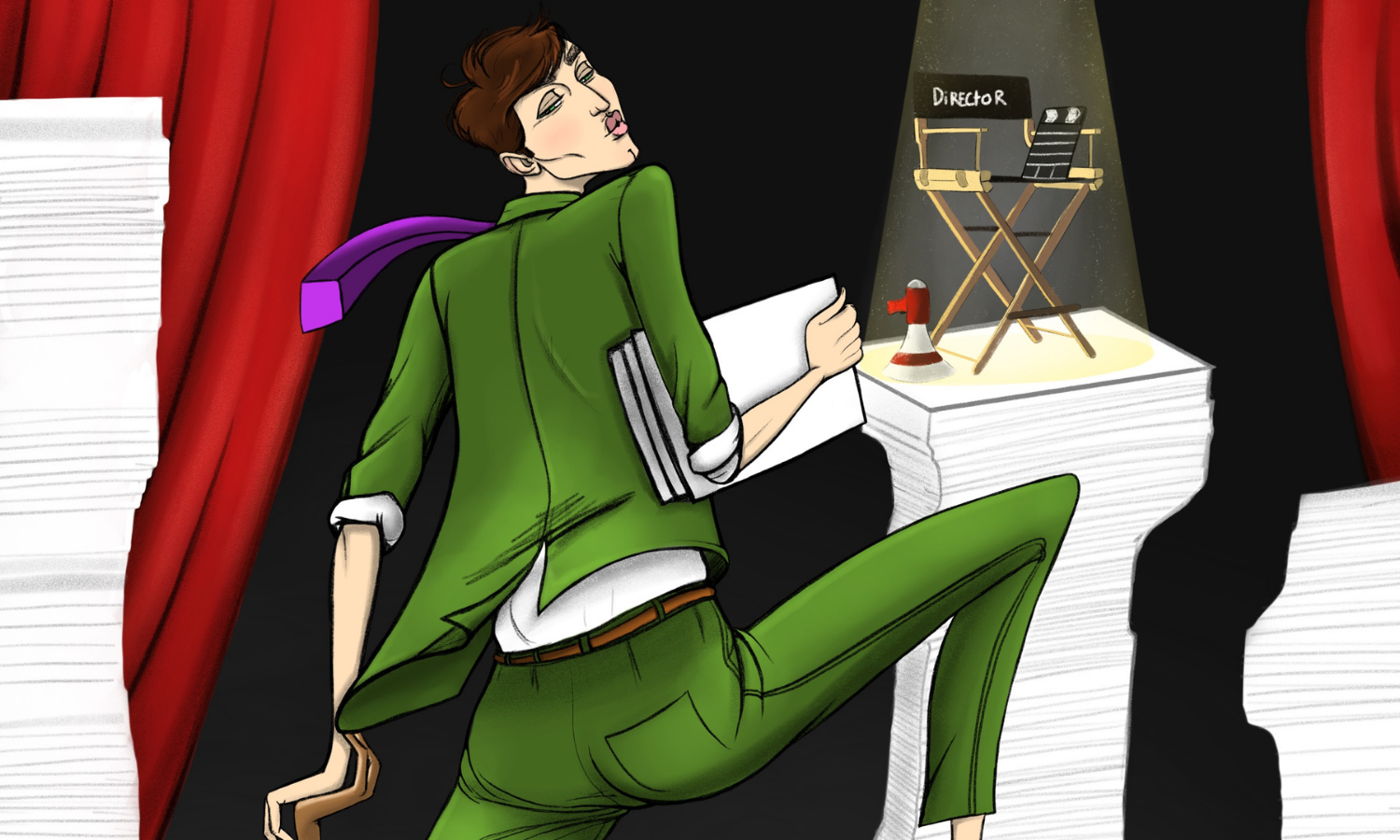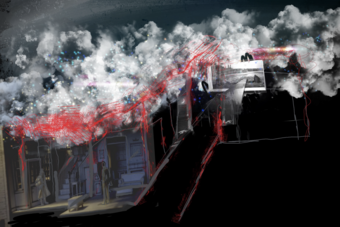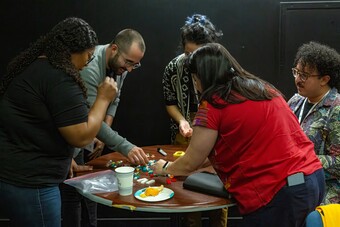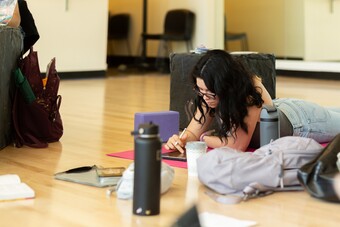Vision. The word has come to almost define the work of a theatre director. Influenced by notions of the auteur film director, in some cases the so-called vision for a theatrical production is all the director is given credit for as an artist. This must change if we are to create a more equitable future. How we conceive of and discuss directing may not seem of primary importance in seeking a more just theatre, but it is a central concern that reflects and embodies many beliefs about how good art is made, how power can and should be used, and what we believe about the individual and the collective.
The laser focus on a director’s vision is problematic. It sets the director up as a prophet rather than a leader. It focuses on a destination, an imagined end goal, and not on the journey. It is individualistic instead of collective. Insidiously, it suggests that the director’s efficacy can be determined by how well they manage to get a team to adhere to their will.
In the collaborative art of theatre, directors cannot achieve a vision alone. If a director’s primary task is to have their personal vision realized, they end up in a situation of necessitated manipulation of others. This manipulation is sometimes enacted kindly and respectfully and sometimes abusively, depending on the disposition of the director and the realities of the particular production—or even the realities of a director’s personal life or emotional capacity at the time. When a director’s vision is centered, abuse is not just possible, but more easily defended as the necessary means of creating good art. This is not healthy leadership.
I do not wish to suggest that every director who has ever spoken of a vision for a production is abusive or non-collaborative. The world and the theatre are complex and subjective. What I mean to point out is some of the insidious implications of commonly used language and ways of thinking about directing. Our attitudes toward and expectations of the director must change and language is a powerful tool to aid that transformation.
Directing is not only the art of choosing an artistic destination. It is also the art of safely guiding collaborators and audiences along an artistic journey, responsive to the realities of each moment of travel. In the theatre, an end goal, a vision, is relatively easy to form—and this can be done in isolation. But an ethical process of achieving a goal is neither simple nor possible to achieve alone. Directors are responsible for the art that ends up onstage but also, as leaders, for the well-being of those creating it. Overemphasizing a director’s vision distracts from this core truth and the possibilities it offers.
When a director’s vision is centered, abuse is not just possible, but more easily defended as the necessary means of creating good art. This is not healthy leadership.
From Vision to Listening and Onward to Dialogue
If we need a metaphor of the senses to describe the work of a director, vision is not it. What if the role of a director was conceived primarily as one of listening rather than visioning? What if the director’s focus was on listening to the play being staged, listening to the artists with whom they are collaborating, listening to the broader culture into which the play is intervening, listening to audiences as they engage with the performance, and, yes, listening to themselves and their own unique understanding of the material?
A great vision for a production of Hamlet might be understood solely in relation to the text: What cool new thing can be done with this canonical work? What might a director do to or impose upon the text? A great listening of Hamlet would involve receptivity to what the text offers, certainly, but also receptivity to what is in contemporary culture that makes Hamlet an important story in a particular time and place. It would also invite the question of whether or not it is, in fact, important. Listening opens up the frame of reference from an internally focused, novelty-seeking theatre to a reflexively situated theatre able to engage in broad cultural dialogue.
What if we take the focus on listening one step farther? Can listening be the starting point for something even more crucial to theatre: dialogue? Even in silent theatre, dialogue is present: dialogue between performer and audience, artistic dialogue within a creative team, the cultural dialogue of which all public acts are a part, and a reflexive dialogue within the director and between the director and the play they are directing. In Pedagogy of the Oppressed, liberatory thinker Paulo Friere teaches that true dialogue requires “a horizontal relationship of which mutual trust between dialoguers is the logical consequence” and that “at the point of encounter there are neither utter ignoramuses nor perfect sages; there are only people who are attempting, together, to learn more than they now know.” Friere’s understanding of dialogue lays the foundation for the collaboration necessary to make theatre.
But what about leadership? As an artist and a leader, a director must have a voice and something to say with it. Good dialogue cannot consist of listening alone but must involve considered response and, at some point, instigation. Directors must listen to themselves and their unique understanding of, relationship with, and connection to a piece if they are to bring themselves into meaningful dialogue with their collaborators and with audiences. This listening to self, however, is not the same as imposing a vision onto something (a playscript, a creative team, an audience). A vision is absolute, messianic, aggrandizing of the director-as-prophet, and leaves little room for dialogue.
Directors cannot lead if they have nothing to offer, nothing to say. By centering listening in place of vision, however, the creative process can become one in which no voice is held above another and many voices can come together in true dialogue. True dialogue enables true collaboration; it is antithetical to the grandstanding of a singular vision. Indeed, as Friere reminds us, “self-sufficiency is incompatible with dialogue.” In theatre perhaps more than anywhere else artists cannot do it alone; we must not pretend that we do, that we could, or that we ever have.
More transfolks in a transphobic space or racialized artists in a racist space is not the progress we should be striving for.
If the theatre field wishes to move beyond diversity and inclusion to the more profound equity—and, even better, justice—then who is in the room is important, but so too is how they are allowed to be in the room. More transfolks in a transphobic space or racialized artists in a racist space is not the progress we should be striving for. Even in consciously compassionate spaces and spaces led by directors from historically marginalized identities, a focus on a singular voice or singular vision does not allow for the productive exchange of multiple viewpoints that characterizes true collaboration. The so-called diversity of a creative team in a space dominated by a singular voice—no matter how well-meaning that voice may be—cannot fully benefit from the breadth of experience, insight, and perspective that is present.
Much abuse has been tolerated on the grounds that it is for some greater good—for example, the good of achieving the all-important artistic vision. Refocusing the work of a director on listening makes this justification impossible. When harm inevitably occurs (for listening and dialogue do not create utopias), a director committed to listening over vision will be better placed to identify and address that harm—including harm they themselves have caused. This foregrounds a director’s responsibility for ethically guiding a team of people.
Listening necessitates a deep appreciation of what a particular team brings to the work. Each team of collaborators is different and a leader is responsible for and to them. It is the unique artistic offerings brought by each member of a creative team—not just the director—that give each production its distinctive character. This should be celebrated.
Listening can also take the pressure off of a director to know, intuit, and/or foresee everything in a process. This is an absolutely unreasonable expectation of anyone—yet somehow an expectation often placed upon directors. A listening, dialoguing director is one with a whole team of collaborators with whom to identify and address the inevitable issues—artistic and otherwise—that arise whenever people come together to create. A visionary director, however, must have all the answers or they have failed. In the theatre, should we not strive to be more than the sum of our parts?











Comments
The article is just the start of the conversation—we want to know what you think about this subject, too! HowlRound is a space for knowledge-sharing, and we welcome spirited, thoughtful, and on-topic dialogue. Find our full comments policy here
As I have reflected on this essay in the more than a year since its publication, it has become clear to me that I have neglected to acknowledge an influence that deeply informed its writing, though not always consciously. Yvette Nolan was probably the first person to suggest to me and, more importantly, to model how a director's vision might not be their central responsibility. Yvette's influence on my thinking (and on so many others) is incredible and I wish to publicly acknowledge and honour it.
team
I agree that the question of “how we herd the cats” is important. But that feels secondary to me. The first question for the director should be “where to herd the cats”? This is why vision is important. I don’t mean vision as something carved is stone but rather the heart if our work. As such, our work begins with listening AND questioning AND sharing. These are required to craft “vision” or “concept”. Peter Brook says that directors are the representatives for the audiences during the process. Our core purpose is to land the heart of the story with an audience. To do that work we must be in relationship with our communities.
So we must have ideas about What is the thing/story/event? Who are we making the thing for?
How will they read the production?
How will it enchant, engage and provoke them?
Only when at least these questions can be answered can a vision be crafted. Then, I think this is where you interest kicks in. The best directors know who to enchant, engage and provoke our collaborators in alignment with that vision. I think we do this by any means necessary. My concern with your point discounting vision is that it risks turning director into traffic cops-concerned only with staging. Even our role as editors requires vision so that there is a touchstone for the process.
it is also incredibly important that there are discussions about what collaboration really means. Many of our collaborators incorrectly assume that collaboration only occurs if their input is utilized. When I’m reality, it mean that their ideas are considered. I teach that collaboration is working to find the best possible solution in the room and coordinate it’s execution. It is listening and hearing and deciding from the choices in the room. It is a great improvisation on how to evolve and achieve the “vision”. I don’t believe that socializing the profession will being us to better art.
In our efforts to get to more equity, we are falling prey to a skepticism about all forms of power; At the precise moment that woman and global majority folks are coming to positions of power. Power is suddenly always a bad thing.
Without a clear vision, we are giving up one of the tools for communicating with the audience. I appreciate your thinking but disagree with you about the utility of vision as a real an useful tool for directors.
Valerie
Valarie,
I so appreciate your nuanced discussion of the article! It has made me think very deeply and for that I’m grateful!
I think there is a great deal of overlap in our understandings of directing. I appreciate, for example, your beautiful description of a director’s purpose (“to land the heart of the story with an audience”) and your key questions to ask in accomplishing this.
I hesitate to agree that we work to “engage, enchant, and provoke” our collaborators “by any means necessary” - I think there are absolutely means that are beyond the scope of what a director can ethically do and that’s central to my concern in this piece. I suppose it comes down to, for me, that how we herd the cats is not secondary to but rather inseparable from where we try to herd the cats - as my mentor Yvette Nolan says, "process and product are the same thing. It’s also important that we recognize that the cats are, in fact, human beings worthy of respect.
That said, I think you bring up an absolutely crucial issue when you highlight the risk of a director being reduced to a traffic cop. To me, listening to the text and listening to oneself (or one’s own artistic impulses and ideas) is crucial to directing. We are collaborators ourselves. And we are artistic leaders. You are absolutely right in arguing that not all power is bad/unethical. Your point about skepticism of power coinciding with increasing gains of it by marginalized communities is also incredibly apt and worth being very conscious of. I feel all of us in the theatre need to be attentive to the dynamics of power (of directors, of identities, and in every other way) and work to find expressions of power that are ethical as well as artistically effective. And I believe this will be different theatre to theatre, production to production.
I’m with you on breaking down exactly what collaboration means - and, I would add, what it feels like when we’re engaged in it. Collaboration, dialogue, isn’t always easy. It will also manifest differently in different artistic environments - and that’s ok. I believe this needs to be part of a dialogue, however, and not silently aken for granted.
To me, the parts of a “vision” that are necessary and important components of directing can be maintained within the concepts of listening to oneself and listening to a text, without the baggage and other implications of “vision” that I highlight in the essay.
I realize now I spelled your name wrong and for that I apologize.
No worries about my name. I have so many of them that they are often misspelled.
I completely agree that we are talking about human beings. I do, however, disagree with the notion that process and product are inextricable and/or the same. I have seen many productions where the artists involved felt great, seen and heard and the work itself was vapid, thin and self-reverential.
When I say “by any means necessary”, I do mean within the bounds of decency and respect. But I don’t promise safety or comfort in the making of a work. I value respect, humility and kindness to help us get through the moments of discomfort in a process. It requires open, honest and direct communication among all of the players in the process. All of whom understand “the where” and I think our job is to facilitate/lead that journey.
thanks for the thought article, even if I’m not sure I agree that demoting vision is a good thing for the art or the craft.
The director's job is to responsibly serve the text. Everything else is just herding cats.
I suppose my interest, here, is in the ethics of how we heard the cats!
Yes, that's the "responsibly" part. thx.
An important thing to emphasize! Thanks Ralph.
Hi Charlie,
Will Davis and I wrote about a director's responsibility and vision awhile back--we were interested in activating vision in the entire ensemble, rather than just the director.
https://howlround.com/how-do-…
Thank you so much for this Michael! I love the thinking you and Will did in this piece.
I love so much of the thinking you two put forward in this piece, but two things stand out to me:
“What if we believed that the most important work was about how a group of people, including the playwright, interpreted the words on the page to create the performance text?”
“If there is any way that a director could be a facilitator, it is here; not to find the one “true” interpretation of a play, but instead to investigate the expression of twenty-plus interpretations of the playwright’s words and cohere those ideas into something that is comprehensible, dynamic, and theatrically vivid.”
These feel like they encapsulate so well the type of collaboration I am hoping to evoke in my own work and call for in this essay.
I’m so glad you shared this essay with me - and I can’t wait to share it with others!
"This must change if we are to create a more equitable future."
"If the theatre field wishes to move beyond diversity and inclusion to the more profound equity—and, even better, justice—"
These are the moral claims, not artistic ones, which reasonable people can and do disagree with.
All well and good to adhere strongly to ones moral ideology, but an ideologue rarely a good artist makes. Mr. Peters seems less interested in artistic curiosity and relegations and more interested in policing the boundaries of ethical behavior according to his narrow and presumed definition. Would be curious to here Mr. Peters make an argument for the truth or goodness of the ethics quoted above. Well, I suppose all religions must have their ruler-wielding Mother Superiors and keyboard inquisitors in addition to their theologians.
Hi Stephen,
I totally agree that I’m making moral claims in this piece. Part of what I’m trying to get at is that directing - like all leadership - is a moral activity and should be understood as such.
I’m a bit confused by the assertion that ideologues rarely make good artists. All art and all artists espouse an ideology. That ideology might be a dominant one, and thus harder to spot from within that ideology, but an ideology is present nonetheless. Part of what I think true dialogue accomplishes is to make those ideologies overt rather than covert and thus subject to discussion and analysis within a collaborative team.
I would offer that I do, in fact, have a great deal of artistic curiosity, but this article focuses on how that curiosity intersects with a leader’s other responsibilities. I tried to avoid hard and fast rules and to present instead a framework for understanding the role of director, so if I failed in that I’d love to discuss how I’ve done so!
Terrific piece, Charlie. Thank you for your clarity and careful thinking. The current use of the term director's vision seems to have come out of the earlier term "concept," which is even more detrimental to equitable practices. Yet, vision can include, if we let it, the practices of equitable collaboration, as you suggest. Thanks again.
Hi Bob, thanks for making the connection with the idea of “a concept.” I think that’s an important, pervasive way of looking at things that I don’t address in the essay.
And I agree that there are elements of what has been called a director’s “vision” which are necessary in the viewpoint for which I’m arguing: in my mind, these fit mostly into the concepts of listening to the text (whatever that may be) and listening to oneself.
Thanks for engaging!